BT7L-IPEX Module Datasheet
Last Updated on : 2025-02-27 07:32:49download
BT7L-IPEX is an embedded low-power Bluetooth module that Tuya has developed. Embedded with the Bluetooth network protocol stack and rich library functions, it consists of a highly integrated Bluetooth chip (TLSR8250F512ET32) and several peripheral circuits.
Overview
BT7L-IPEX contains a low-power 32-bit MCU, Bluetooth LE 5.0, 2.4 GHz radio, 512-KB flash memory, 48-KB SRAM, and 7 reusable I/O interfaces.
Features
- Embedded low-power 32-bit MCU, which can also function as an application processor
- Clock rate: 48 MHz
- Working voltage: 1.8 V to 3.6 V (Under 1.8 V to 2.7 V, the module can start but the RF performance is not guaranteed. Under 2.8 V to 3.6 V, the module performance is normal.)
- Peripherals: one Inter-Integrated Circuit (I2C) bus, four pulse width modulation (PWM) pins, and one universal asynchronous receiver/transmitter (UART)
- Bluetooth LE RF features
- Compatible with Bluetooth LE 5.0
- Data transmission rate: Up to 2 Mbit/s RF data rate
- TX power: +10 dBm
- RX sensitivity: –94.5 dBm at Bluetooth LE 1 Mbit/s
- Embedded Advanced Encryption Standard (AES) hardware encryption
- Onboard PCB antenna
- Working temperature: -40°C to +85°C
Applications
- Smart LED lights
- Smart households
- Smart low-power sensors
Module interfaces
Dimensions and footprint
BT7L-IPEX has two lines of pins with a pin spacing of 1.5 mm.
The BT7L-IPEX dimensions (H x W x L) are 2.85 ±0.15mm x 15±0.35 mm x 16.5±0.35 mm. The following figures show the top and bottom views.

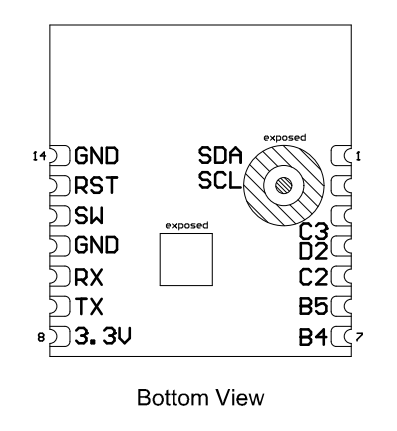
Pin definition
| Pin No. | Symbol | I/O type | Function |
|---|---|---|---|
| 1 | SDA | I/O | I2C data cable pin, which can be used as a common I/O pin and is connected to the PC0 pin on the internal IC |
| 2 | SCL | I/O | I2C clock cable pin, which can be used as a common I/O pin and is connected to the PC1 pin on the internal IC |
| 3 | C3 | I/O | Common I/O pin, which can be used as a PWM output of the LED drive and is connected to the PC3 pin on the internal IC (By default, the pin controls the cold green light.) |
| 4 | D2 | I/O | Common I/O pin, which can be used as a PWM output of the LED drive and is connected to the PD2 pin on the internal IC (By default, the pin controls the cold blue light.) |
| 5 | C2 | I/O | Common I/O pin, which can be used as a PWM output of the LED drive and is connected to the PC2 pin on the internal IC (By default, the pin controls the cold warm white light.) |
| 6 | B5 | I/O | Common I/O pin, which can be used as a PWM output of the LED drive and is connected to the PB5 pin on the internal IC (By default, the pin controls the cold cold white light.) |
| 7 | B4 | I/O | Common I/O pin, which can be used as a PWM output of the LED drive and is connected to the PB4 pin on the internal IC (By default, the pin controls the cold red light.) |
| 8 | 3V3 | P | Power supply pin |
| 9 | TX | I/O | Serial interface transmission pin, which can be used as a common I/O pin and is connected to the PB1 pin on the internal IC |
| 10 | RX | I/O | Serial interface receiving pin, which can be used as a common I/O pin and is connected to the PB7 pin on the internal IC |
| 11 | GND | P | Power supply reference ground pin |
| 12 | SW | I/O | Bluetooth chip programming pin, which is connected to the SWS pin on the internal IC |
| 13 | RST | I | Reset pin, which is connected to the RESETB pin on the internal IC (The module is embedded with a pull-up resistor.) |
| 14 | GND | P | Power supply reference ground pin |
Note: P indicates a power supply pin, and I/O indicates an input/output pin.
If you have any other special requirements on light colour controlled by the PWM output, contact Tuya business personnel.
Electrical parameters
Absolute electrical parameters
| Parameter | Description | Minimum value | Maximum value | Unit |
|---|---|---|---|---|
| Ts | Storage temperature | –65 | 150 | °C |
| VCC | Power supply voltage | –0.3 | 3.9 | V |
| ESD voltage (human body model) | Tamb-25°C | N/A | 2 | kV |
| ESD voltage (machine model) | Tamb-25°C | N/A | 0.5 | kV |
Working conditions
| Parameter | Description | Minimum value | Typical value | Maximum value | Unit |
|---|---|---|---|---|---|
| Ta | Working temperature | -40 | N/A | 85 | °C |
| VCC | Working voltage | 2.8 | 3.3 | 3.6 | V |
| VIL | I/O low-level input | VSS | N/A | VCC*0.3 | V |
| VIH | I/O high-level input | VCC*0.7 | N/A | VCC | V |
| VOL | I/O low-level output | VSS | N/A | VCC*0.1 | V |
| VOH | I/O high-level output | VCC*0.9 | N/A | VCC | V |
Current consumption
| Symbol | Condition | Typical value | Peak value (Typical value) | Unit |
|---|---|---|---|---|
| Itx | Continuous TX, 10 dBm output power | 16.8 | 18.4 | mA |
| Itx | Continuous TX, 0 dBm output power | 6.3 | 8.8 | mA |
| Irx | Continuous RX | 6.3 | 8.9 | mA |
| IDC | Network pairing | 6.8 | 32 | mA |
| IDC | Connected | 6.8 | 32 | mA |
RF features
Basic RF features
| Parameter | Description |
|---|---|
| Working frequency | 2.4 GHz ISM band |
| Wireless standard | Bluetooth LE 5.0 |
| Data transmission rate | 1 Mbit/s, 2 Mbit/s |
| Antenna type | IPEX antenna |
RF TX power
| Parameter | Minimum Value | Typical Value | Maximum Value | Unit |
|---|---|---|---|---|
| Average RF output power | –22 | 10 | 10.5 | dBm |
| 20 dB modulation signal bandwidth (1 Mbit/s) | N/A | 2500 | N/A | kHz |
| 20 dB modulation signal bandwidth (2 Mbit/s) | N/A | 2600 | N/A | kHz |
RF RX sensitivity
| Parameter | Minimum value | Typical value | Maximum value | Unit |
|---|---|---|---|---|
| RX sensitivity (1 Mbit/s) | N/A | –94.5 | N/A | dBm |
| RX sensitivity (2 Mbit/s) | N/A | –90 | N/A | dBm |
| Frequency offset error (1 Mbit/s) | –300 | N/A | +300 | kHz |
| Frequency offset error (2 Mbit/s) | –200 | N/A | +200 | kHz |
| Co-channel interference suppression | N/A | –7 | N/A | dB |
Antenna
Antenna type
BT7L-IPEX uses the first-generation IPEX antenna base:
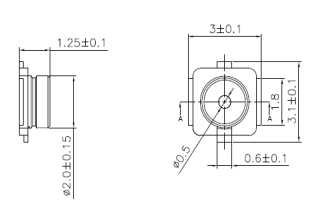
BT7L-IPEX uses the FPC-IPEX antenna:
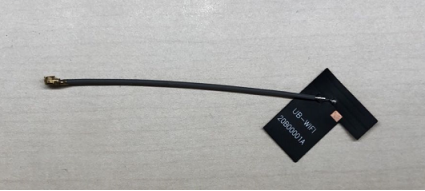
Antenna interference reduction
To ensure optimal RF performance, it is recommended that the antenna be at least 15 mm away from other metal parts. Do not wrap the metal parts around the antenna to avoid affecting the radiation performance of the antenna. It is recommended to cut out the adapter plate in the antenna area.
Packaging information and production instructions
Mechanical dimensions and rear solder pad dimensions
Top view
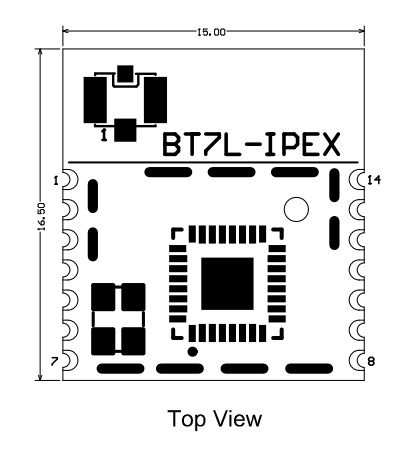
Bottom view

Side view
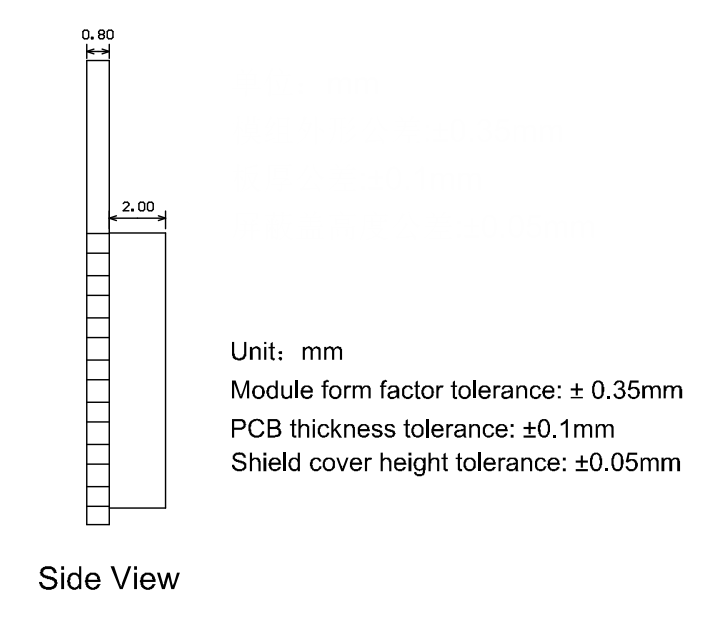
Recommended footprint
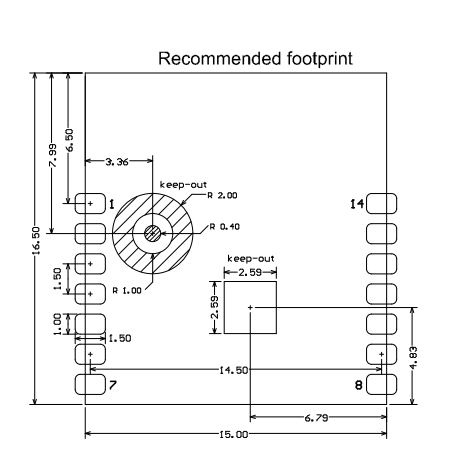
Note: The default dimensional tolerance is ±0.35 mm, and the tolerance for key dimensions is ±0.1 mm. If you have any other special requirements, clearly specify them in the datasheet after communication.
Schematic diagram of the footprint
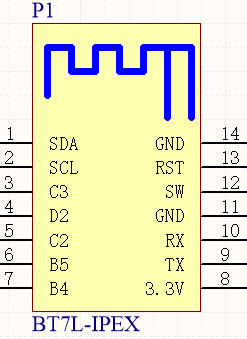
Production instructions
- The Tuya SMT module should be mounted by the SMT device. After being unpacked, it should be soldered within 24 hours. Otherwise, it should be put into the drying cupboard where the RH is not greater than 10%; or it needs to be packaged under vacuum again and the exposure time needs to be recorded (the total exposure time cannot exceed 168 hours).
- SMT devices:
- Mounter
- SPI
- Reflow soldering machine
- Thermal profiler
- Automated optical inspection (AOI) equipment
- Baking devices:
- Cabinet oven
- Anti-electrostatic and heat-resistant trays
- Anti-electrostatic and heat-resistant gloves
- SMT devices:
- Storage conditions for a delivered module:
-
The moisture-proof bag must be placed in an environment where the temperature is below 40°C and the relative humidity is lower than 90%.
-
The shelf life of a dry-packaged product is 12 months from the date when the product is packaged and sealed.
-
There is a humidity indicator card (HIC) in the packaging bag.
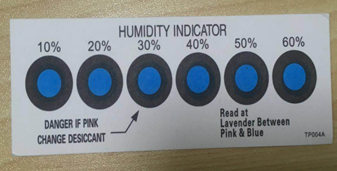
-
- The module needs to be baked in the following cases:
- The packaging bag is damaged before unpacking.
- There is no HIC in the packaging bag.
- After unpacking, circles of 10% and above on the HIC become pink.
- The total exposure time has lasted for over 168 hours since unpacking.
- More than 12 months have passed since the sealing of the bag.
- Baking settings:
- Temperature: 40°C and ≤ 5% RH for reel package and 125°C and ≤5% RH for tray package (please use the heat-resistant tray rather than plastic container)
- Time: 168 hours for reel package and 12 hours for tray package
- Alarm temperature: 50°C for reel package and 135°C for tray package
- Production-ready temperature after natural cooling: < 36°C
- Re-baking situation: If a module remains unused for over 168 hours after being baked, it needs to be baked again.
- If a batch of modules is not baked within 168 hours, do not use the reflow soldering to solder them. Because these modules are Level-3 moisture-sensitive devices, they are very likely to get damp when exposed beyond the allowable time. In this case, if they are soldered at high temperatures, it may result in device failure or poor soldering.
- In the whole production process, take electrostatic discharge (ESD) protective measures.
- To guarantee the passing rate, it is recommended that you use the SPI and AOI to monitor the quality of solder paste printing and mounting.
Recommended oven temperature curve
Set oven temperatures according to the following temperature curve of reflow soldering. The peak temperature is 245°C.

-
A: Temperature axis
-
B: Time axis
-
C: Liquidus temperature: 217 to 220°C
-
D: Ramp-up slope: 1 to 3°C/s
-
E: Duration of constant temperature: 60 to 120s; the range of constant temperature: 150 to 200°C
-
F: Duration above the liquidus: 50 to 70s
-
G: Peak temperature: 235 to 245°C
-
H: Ramp-down slope: 1 to 4°C/s
Note: The above curve is just an example of the solder paste SAC305. For more details about other solder pastes, please refer to Recommended oven temperature curve in the solder paste specifications.
Storage conditions
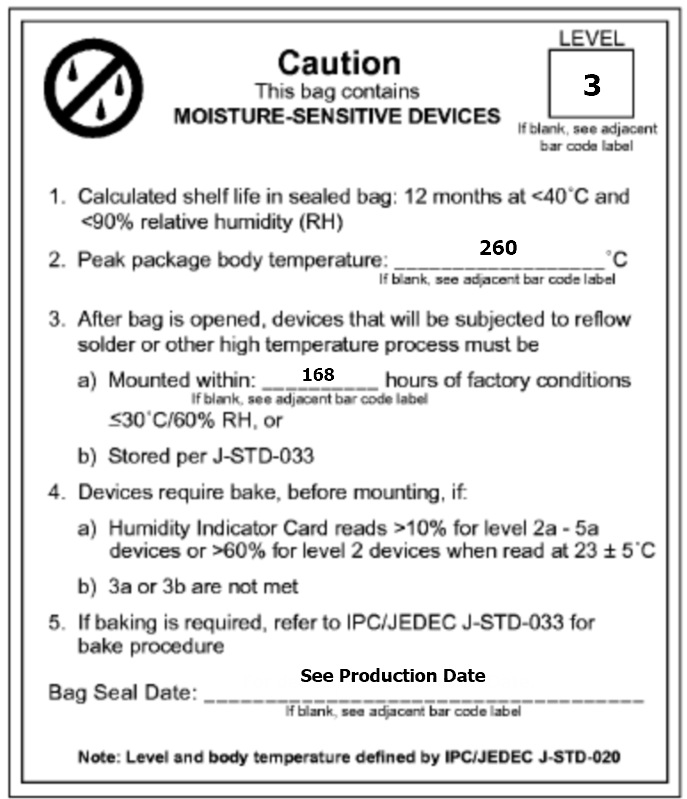
MOQ and packing information
| Product model | MOQ | Packing Method | Number of modules per reel | Number of reels per carton |
|---|---|---|---|---|
| BT7L-IPEX | 4000 | Tape reel | 1000 | 4 |
Appendix: Statement
Federal Communications Commission (FCC) Declaration of Conformity
FCC Caution: Any changes or modifications not expressly approved by the party responsible for compliance could void the user’s authority to operate this equipment.
This device complies with Part 15 of the FCC Rules. Operation is subject to the following two conditions: (1) This device may not cause harmful interference, and (2) this device must accept any interference received, including interference that may cause undesired operation.
Note: This equipment has been tested and found to comply with the limits for a Class B digital device, pursuant to part 15 of the FCC Rules.
These limits are designed to provide reasonable protection against harmful interference in a residential installation. This equipment generates, uses, and can radiate radio frequency energy and, if not installed and used in accordance with the instructions, may cause harmful interference to radio communications. However, there is no guarantee that interference will not occur in a particular installation.
If this equipment does cause harmful interference to radio or television reception, which can be determined by turning the equipment off and on, the user is encouraged to try to correct the interference by one or more of the following measures:
- Reorient or relocate the receiving antenna.
- Increase the separation between the equipment and receiver.
- Connect the equipment to an outlet on a circuit different from that to which the receiver is connected.
- Consult the dealer or an experienced radio/TV technician for help.
Radiation Exposure Statement
This equipment complies with FCC radiation exposure limits set forth for an uncontrolled environment. This equipment should be installed and operated with a minimum distance of 20 cm between the radiator and your body.
Important Note
This radio module must not be installed to co-locate and operate simultaneously with other radios in host system except in accordance with FCC multi-transmitter product procedures. Additional testing and equipment authorization may be required to operate simultaneously with other radio.
The availability of some specific channels and/or operational frequency bands is country dependent and firmware programmed at the factory to match the intended destination. The firmware setting is not accessible by the end user.
The host product manufacturer is responsible for compliance to any other FCC rules that apply to the host not covered by the modular transmitter grant of certification. The final host product still requires Part 15 Subpart B compliance testing with the modular transmitter installed.
The end user manual shall include all required regulatory information/warning as shown in this manual, including: This product must be installed and operated with a minimum distance of 20 cm between the radiator and user body.
The RF module is considered as a limited modular transmitter according to FCC rules. Even though the RF module gets an FCC ID, the host product manufacturer can not use the FCC ID on the final product directly. In these circumstances, the host product manufacturer integrator will be responsible for re-evaluating the end product (including the transmitter) and obtaining the FCC authorization by a Class II permissive change application or a new application.
Declaration of Conformity European Notice

Hereby, Hangzhou Tuya Information Technology Co., Ltd. declares that this module product is in compliance with essential requirements and other relevant provisions of Directive 2014/53/EU, 2011/65/EU. A copy of the Declaration of Conformity can be found at https://www.tuya.com.

This product must not be disposed of as normal household waste, in accordance with the EU directive for waste electrical and electronic equipment (WEEE-2012/19/EU). Instead, it should be disposed of by returning it to the point of sale, or to a municipal recycling collection point.
The device could be used with a separation distance of 20 cm from the human body.
Is this page helpful?
YesFeedbackIs this page helpful?
YesFeedback





